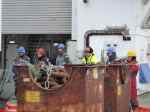by Winnie Courtene-Jones, Scottish Association for Marine Science
The deep sea conjures up visions of a realm that is deep, dark and devoid of life, however this reputation is not true. The deep sea is the portion of our oceans off the continental shelf and deeper than 200 m, this makes up a large proportion of our planet (around 80 % of the oceans is classified as ‘deep-sea’) and supports a huge diversity of marine life, including many commercially important species.
The deep sea faces a number of anthropogenic threats, including fisheries, mineral exploitation and litter, especially plastics. Plastic is an extremely durable material, meaning that while it breaks up into ever smaller pieces it does not completely vanish. These small plastic particles are termed microplastics and are of particular concern, as they are bioavailable to a wide diversity of organisms which may eat them mistaking them for food. Indeed over 600 different species have been found to ingest microplastics, and microplastic pollution has been identified throughout the natural world: in terrestrial, freshwater and marine systems, and from sea surface to the seafloor.
It is thought that marine plastics and microplastics sink through the water column and ultimately reside on the seafloor. However, limited research has focussed on microplastic pollution in the deep sea and we do not know, as yet, the quantities of microplastics present in the deep ecosystem, how these may interact with organisms, and the pathways and timescales for microplastics to transit to the deep oceans.
My work broadly focusses on researching microplastics in the deep sea environment, attempting to answer some of these unknowns. I have been lucky enough to sail on the Extended Ellett Line both this year and last year to collect data. Participating in these scientific expeditions is a real highlight for me, I gain such amazing personal and professional experiences. Collecting data on microplastics only takes up a proportion of my time; therefore whilst on board I also assist with chemistry sampling and analysis. While I find this work extremely interesting and insightful, to a biologist (me) nothing can beat being out on deck undertaking and sorting through sediment cores!
It was an early start this morning, long before the sun came up, to deploy the megacore; this takes multiple cores of the sediment via long tubes (similar to an ice core). Once the megacore is brought back on deck, the core tubes are carefully removed, and the sediment sliced into depth sections on board. These depth sections equate to different periods in time and can be dated using various analytical techniques. The sediments were preserved for microplastic analysis once back in on land.
Everyone on board was interested to see the operations and as the night shift drew to an end and the morning shift commenced the fresh faces appeared around the sediment cores offering to assist and curious about the processes involved. The Extended Ellett Line Cruise is such a valuable opportunity to bring together scientists from a range of disciplines, and while everyone’s own research differs, everyone is willing to lend a hand with any task that needs to be done.
A very successful day!
Photos by Antonia Doncila
-

-
170517 happy team slicing sediment
-

-
170517 deploying the megacore
-

-
170517 removing the cores
-

-
170517 extruding the sediment from the core
-

-
170517 slicing the sediment




































































